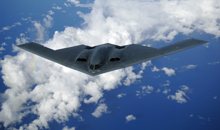The next US bomber will be subsonic and manned, the US Air Force has decided, ruling out supersonic and unmanned possibilities and the option of an FB-22 derivative of its F-22A Raptor stealth fighter.
Speaking at the Air Force Association’s Eaker Institute this week, Brig Gen Mark Matthews, director of plans and programmes at USAF Air Combat Command, said an analysis of alternatives for long-range strike has shown that a “new concept aircraft” best meets the requirements for a next-generation bomber in the 2018 timeframe.
Matthews said the technology available to meet the requirement to penetrate hostile air defences and persist over the target area points to a manned, subsonic aircraft.
The recently completed analysis of alternatives looked at the matrix of long-range strike options: subsonic and supersonic, manned and unmanned.
|
|
|---|
The next-generation bomber is expected to have a weapons payload of 14,000-28,000lb (6,500-13,000kg) and an unrefuelled radius of more than 2,000nm (3,700nm).
This places it between the USAF’s Boeing F-15E strike aircraft and Northrop Grumman B-2 stealth bomber, which has a 40,000lb payload and an unrefuelled range exceeding 6,000nm.
Matthews said the decision to go subsonic was determined by the technology available to meet the payload/range requirements by 2018, the USAF’s target for initial operational capability of the next-generation bomber.
The aircraft will feature advanced low-observability, he said, to enable it to penetrate hostile air defences and survive and persist over enemy territory to “find and fix” moving and hidden targets.
The bomber will be manned because the USAF needs the flexibility and adaptability of a crew in the aircraft to make decisions and react to the dynamic battle environment, Matthews said.
The USAF plans to explore advances in propulsion as well as advanced sensors and weapons and network-centric technologies, he said.
With the B-2 expected to remain in service until 2050, Northrop is proposing upgrades to keep the aircraft viable as a penetrating bomber beyond 2020.
Source: FlightGlobal.com


















